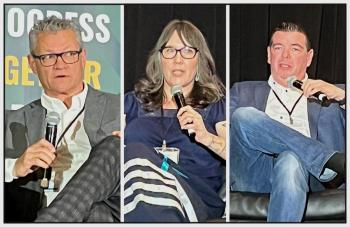Image Caption
Local Journalism Initiative Reporter
Windspeaker.com
Jason Batise is a firm believer in laying all his cards out on the table.
Batise is the executive director of the Wabun Tribal Council, which represents six Ojibwe and Cree First Nations in northern Ontario.
Batise was a panelist at a session titled The Renewable Energy Journey at the Indigenous Led Projects Forum held in Toronto in early April.
The two-day event, which concluded April 3, was staged at the Sheraton Centre Toronto Hotel.
During his afternoon presentation April 2, Batise said representatives from Indigenous communities need to be transparent with their industry partners and inform them of all their wishes and demands up front about projects being developed on their lands.
The Wabun Tribal Council represents the First Nations of Beaverhouse, Brunswick House, Chapleau Ojibwe, Flying Post, Matachewan and Mattagami.
“Our communities now enjoy five hydro-electric projects that are in our territory,” Batise said. “And we’re anxious to get to more if we can, and any other renewable energy projects that folks might have in mind.”
Batise said these projects came to fruition because First Nations reps had a seat at the project development tables alongside government and industry players.
Besides getting non-Indigenous partners on board with various initiatives, Batise said it can be equally as challenging to get Indigenous communities to agree to certain projects.
“It’s not an easy conversation,” he said. “You have to convince the community that the compromise that you are asking them to make is worthwhile. Then you move into this equity conversation. If we don’t own it, why would we do it? If somebody else is going to own this thing on our land, how the heck am I going to convince the community to come along on board?”
Another panelist on The Renewable Energy Journey session was Jennifer Ashawasegai-Pereira, a former communications consultant for Henvey Inlet First Nation in Ontario.
Ashawasegai-Pereira spoke about Henvey Inlet Wind, a 300-megawatt wind project that was completed in her First Nation in 2019. The project includes a 100-kilometre transmission line from Henvey Inlet to Parry Sound.
Ashawasegai-Pereira said the concept for the wind project dates back to 2009 when the Green Energy Act was introduced in Ontario. Since her First Nation is situated beside wind-swept Georgian Bay, numerous developers contacted Harvey Inlet officials about partnering for a wind project.
“Since we had developers knocking on our door, we thought this might be a really good idea,” Ashawasegai-Pereira said. “So, we talked amongst ourselves, thought it would be a good idea and then we did our due diligence. Part of our due diligence was also wanting to have a good partnership. One of the things we wanted was a 50-50 partnership. We weren’t going to settle for less.”
Harvey Inlet First Nation reps eventually found Pattern Energy, a company willing to agree to terms.
“One of the things that Pattern did, we hear about these things all the time, is engage early and engage often,” said Ashawasegai-Pereira. “And they did that.”
Like Batise discussed, Ashawasegai-Pereira also said reps from her First Nation had to convince community members of the positives of the project.
“We spent a lot of time doing consensus building,” she said. “Not everybody agreed with the project. Everybody still doesn’t agree with the project. But we’ve had that consensus and the ability to think about our next seven generations and beyond through that wealth management, through the trust and then people have better educations, better programming on reserve and some of the building of new infrastructure. So those are all very important aspects of the project.”
The Renewable Energy Journey was one of two afternoon sessions during the opening day of the forum.
The other afternoon session that day was titled Energy Storage Innovation.
This panel included Matt Jamieson, CEO of the Six Nations of the Grand River Development Corporation in Ontario.
Jamieson spoke about the Oneida Energy Storage project, which will be operational by May of 2025.
“I think the Oneida project is a classic example of an Indigenous-led project,” he said. “The whole idea of creating a large grid-connected energy storage (facility) really came from our boardroom.”
And it is indeed a project Six Nations officials can boast about.
“It’s a $700-million project, 250-megawatt of four-hour cycle time, so 1,000 megawatts of energy storage product, the largest of its kind in Canada,” Jamieson said. “And the third largest in North America. We’re very proud of it because, again, we were able to get our fingerprints on it.”
Local Journalism Initiative Reporters are supported by a financial contribution made by the Government of Canada.

